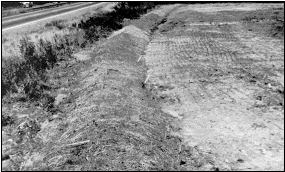 |
 |
To Print Use The pdf File
ILLINOIS URBAN MANUAL
PRACTICE STANDARD
TEMPORARY DIVERSION
(feet)
CODE 955
 (Source: VA Erosion and Sediment Control Handbook) |
DEFINITION
A temporary ridge or excavated channel or combination ridge and channel constructed across sloping land on a predetermined grade.
PURPOSE
The purpose of this practice is to protect work areas from upslope runoff and to divert sediment-laden water to an appropriate sediment trapping facility or stabilized outlet.
CONDITIONS WHERE PRACTICE APPLIES
This practice applies to construction areas where runoff can be diverted and disposed of properly to control erosion, sedimentation, or flood damage. Specific locations and conditions include:
CRITERIA
Temporary diversions must be planned to be stable throughout their useful life and to meet the criteria given below. Those not meeting the criteria stated below will be designed as permanent diversions. See practice standard DIVERSION 815.
| Top Width (ft.) |
Height (ft.) | Side Slopes |
|---|---|---|
| 0 | 1.5 | 4:1 |
| 4 | 1.5 | 2:1 |
Maximum
| Land Slope (%) | Spacing (ft.) |
|---|---|
| 1 or less | 300 |
| 2 – 3 | 200 |
| 3 – 5 | 150 |
| 5 or greater | 100 |
CONSIDERATIONS
It is important that diversions are properly designed, constructed and maintained since they concentrate water flow and increase erosion potential. Particular care must be taken in planning diversion grades. Too much slope can result in erosion in the diversion channel or at the outlet. A change of slope from steeper grade to flatter may cause deposition to occur. The deposition reduces carrying capacity and may cause overtopping and failure.
Frequent inspection and timely maintenance are essential to the proper functioning of diversions. Sufficient area must be available to construct and properly maintain diversions.
It is usually less costly to excavate a channel and form a ridge or dike on the downhill side with the spoil than to build diversions by other methods. Where space is limited, it may be necessary to build the ridge by hauling in diking material or using a silt fence to divert the flow. Use gravel to armor the diversion dike where vehicles must cross frequently.
Temporary diversions may serve as in-place sediment traps if over excavated 1 to 2 feet and placed on a nearly flat grade. The dike serves to divert water as the stage increases. A combination silt fence and channel in which fill from the channel is used to stabilize the fence can trap sediment and divert runoff simultaneously.
Wherever feasible, build and stabilize diversions and outlets before initiating other land-disturbing activities. Construction of diversions will be in compliance with Illinois drainage laws.
PLANS AND SPECIFICATIONS
Plans and specifications for installing temporary diversions shall be in keeping with this standard and shall describe the requirements for applying the practice to achieve its intended purpose. At a minimum include the following items:
All plans shall include the installation, inspection, and maintenance schedules with the responsible party identified.
Construction of the diversion shall meet the requirements as listed in the construction specification 27 DIVERSIONS AND WATERWAYS; standard drawing IL-655 TEMPORARY DIVERSION PLAN may be used as the plan sheet.
OPERATION AND MAINTENANCE
Inspect temporary diversions once a week and after every rainfall. Immediately remove sediment from the flow area and repair the diversion ridge. Carefully check outlets and make timely repairs as needed. When the area protected is permanently stabilized, remove the ridge and the channel to blend with the natural ground level and appropriately stabilize it.
NRCS IL August 1994